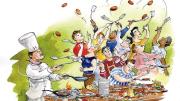1919
The Faculty of Arts and Sciences, “a pioneer without being precipitate,” votes to establish general examinations for the A.B. in all departments, consonant with President Lowell’s view that no mere aggregation of credits merits a degree unless the student can also prove that he knows “some one thing well.”
1929
The Student Council reports “a real and urgent need of advice” for undergraduates choosing vocations and urges establishment of an office to provide it.
1934
The Federal Emergency Relief Administration announces a special fund to help needy students finish the academic year, but Harvard College says it has money enough for its own students and will not apply for an allotment.
1959
Harvard and MIT establish a Joint Center for Urban Studies to search out the basic facts in the tangled problems of big-city growth.
1964
From President Pusey to undergraduates, Harvardians rally against a Metropolitan District Commission plan to build a 400-foot underpass at the junction of Memorial Drive and Boylston [now Kennedy] Street, near the Larz Anderson Bridge.
1999
On the same day a large student rally against sweatshop labor in clothing manufacturing occurs in the Yard, Harvard endorses a policy of “full disclosure” obligating manufacturers of licensed apparel to reveal the location of their factories.
Harvard Dining Services’ executive chef, Michael Miller, has developed a five-session, $25 course, “Cooking for the Culinarily Challenged,” to help students survive once they leave the Yard.
2004
The University launches the Harvard Stem Cell Institute, engaging seven of its schools and six affiliated hospitals in both research and clinical efforts focused on using stem cells to correct organ failure.
On April 1, for the first time in Harvard history, more women (1,016) than men (1,013) are offered admission to the College.









